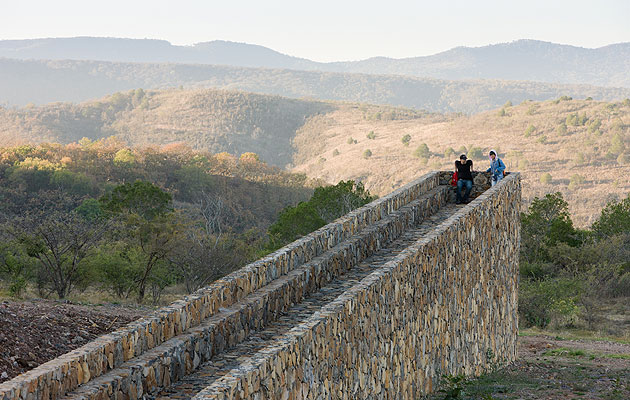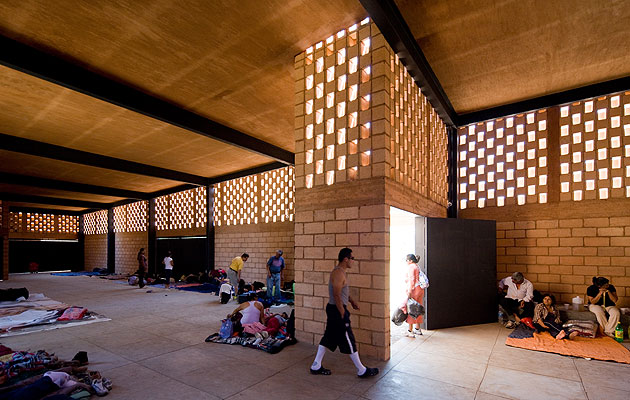|
|
||
|
Four flat pillars shoot towards the Mexican heavens, a small but majestic flash in their hazy valley. Behind, the little town of Lagunillas reclines in the sun. From two hours’ steep walk away, they evoke the Biblical story of Lot’s wife, turned into a pillar of salt as she looked back at Sodom. At close range, though, the pillars form the outline of a giant crucifix. In white concrete marked by its formwork, they are an open chapel, designed to provide shade, be leaned against and receive prayers. Named Gratitude, the chapel was designed by Mexico City architects Derek Dellekamp and Tatiana Bilbao. Stuck high up into the tallest, 28m high, pillar, a small piece of iron represents the wound in Jesus’ side. It is beginning to leak rust, imitation blood. This is the first stop on the Ruta del Peregrino, or Pilgrim’s Route, project – one of the most thoughtful architectural schemes in Mexico for decades. Now close to completion, it will provide a series of nine contemporary structures, shelters, chapels and lookout points along the 117km route from the town of Ameca to the church in Talpa de Allende, which has been attracting pilgrims for the 366 years since it played host to a miraculous apparition attributed to the Virgin Mary. Dellekamp and Bilbao, working with architect Rozana Montiel, orchestrated a group of young international architects to come together for the project, each picking a site and creating their own vision. The 3 million pilgrims that make the annual three-day hike to Talpa will have a look at modern architecture the like of which most of them will never have seen. “It’s pretty unique, programmatically,” says Dellekamp. “These are really abstract pieces of architecture. It’s more land art than architecture – and there isn’t anything else like it in Mexico.”
The architecture may not be internationally ground-breaking – but in Mexico, given the theme, it is revolutionary. The Ruta del Peregrino achieves the rarely attempted: to make Mexican Catholicism cool. As far as Mexico is concerned, the kitschier the decor, the holier the church. This has been going on for centuries, and the route to Talpa is no exception. The facade of one church along the way is a collage of china plates. Another has at the top of its steeple a neon red cross. But this is what the pilgrims are used to and, until the government’s publicity campaign takes off, they will be the main audience for the new structures. The project’s immediate challenge is to connect with these walkers – Catholics of all ages, mostly from Jalisco state, in which the route lies, and mostly arriving in Holy Week – and provide something relevant to them. While it does not attempt to replace established chapels and shelters, or use architectural muscle to detract attention from the route, neither does it defer entirely to pilgrims’ expectations. It goes for the middle ground: challenging, but on familiar soil. “To make a spot where nature and the pilgrim understand the territory through the building,” is architect Luis Aldrete’s take on it. Though every architect has created something abstract and personal, religion and nature are also integral to the project. The lookout point by Elemental, the practice featuring Chilean architects Alejandro Aravena and Diego Torres, is an exemplary case. What looks like a periscope peeps out from the top of the Devil’s Spine, the most difficult part of the hike. A rectangular concrete box – missing two sides – appears to have crashed from the sky like Dorothy’s house arriving in Oz, and bent in two upon impact, with the middle as its lowest point. One of the gaps, framed by roble trees, looks over the hill just climbed and deep down into the valley below. The other looks towards a patch of pine trees and white crosses, traditionally planted on behalf of would-be pilgrims who are too old or sick to make it. It is a passage from one landscape into another, lit only by a small skylight with tracery that projects the Virgin Mary’s image on to the floor. Or, it is an invitation to the most daredevil of skateboarders – so much so that it is the only structure coated with greenish-grey anti-graffiti paint. Less than a year old, it has aged quickly, with salt stalactites forming on the ceiling and a large agave plant growing peacefully underneath. The Devil’s Spine looks down on the most showy work, the Swiss firm HHF Architects’ Guava Tree lookout point. Centred on a continuous spiral staircase, its pushed-over arches, walls peeling off from each other at curves and large viewing platform come together surreally, a dreamy Remedios Varo castle. Meanwhile, the Chinese artist Ai Weiwei – best known as co-designer of the Beijing Olympic Stadium – fittingly contributes a giant diving board to the Jaliscan sierra. His practice Fake Design’s walkway of an open chapel cuts into a hill on its northern side and plunges out into the southern air. Paved with local grey and amber stone, it is like a long, deep drainage system. The pilgrims’ path cuts it in half, so that when you enter you can choose to go right – north – with your surroundings blocked out by the high walls, leaving only views of the sky and the hill ahead of you. Or you can go south and sit on the ridge that goes all the way around the edge, on top of nature. It’s a bare structure. But being, as it is, about yin and yang and heaven and hell, the lack of much to look at does leave one’s attention free for reflection. Luis Aldrete’s two shelters, the only non-concrete structures, are less overtly religious. Made of bricks from local red earth, they blend in well enough not to be noticed until they are pointed out. They are airy and spacious, with a wide section of brick jali to let the wind and a faint light in, and have the hushed, dim atmosphere of an empty church. In high season, hundreds of pilgrims are wedged in here side by side like cigarettes in a box. The shelters are a place to sleep, though most will only rest a few hours before getting up to walk in the early morning cool. “You are in the countryside, going in the car, and you just see lots of beautiful landscape. But you see a church or a tower and it gives meaning to the landscape, gives it context. That’s what I’m trying to do – inject meaning into the territory,” says Aldrete. Juan Rulfo, one of Mexico’s most famous authors, wrote a short story in which a sick man is dragged along this route by his wife and brother, who are having an affair. The guilty lovers know that the journey will kill him, and indeed he dies of exhaustion when he gets to the church in Talpa. On the final stretch, to do penance, he walks wearing a crown of thorns. The Void Temple, the final structure, designed by Dellekamp with Rozana Montiel’s practice Periférica, inescapably evokes this crown, or a halo dropped from heaven. “I am really passionate about symbols. I thought universal symbols were the way to go, and circles are certainly a universal symbol,” says Dellekamp. “We looked at a lot of photos of circles – Stonehenge, African children sitting down making a circle with their feet.” A ring of white concrete balances among trees in a wood, cutting off a section of nature. A free-standing 3m high gap under one side lets you out and shows what a challenge it was not to alter the landscape. That something like this project, funded and organised by the government, has managed to take place at all is a big step in Mexico. To come this far – with only two structures, by Tatiana Bilbao and Christ & Gantenbein, still to be built – has required the agreement of all the local municipalities, the Church and the donation of most of the land on which the structures stand. It has required some serious diplomacy. The first structure, the chapel of pillars, is built on an old maize field that used to belong to Lagunillas. An ejido, a group of over 70 representatives of the community, decided to donate their farmland – despite the chapel’s deeply unfamiliar style. Don José, its president, was the driving force. “Well, some people didn’t come to the meeting about the sculpture, so they couldn’t vote,” he smiles. “So we got a majority. And now everyone comes and stops and looks at it.” Don José has a particular interest, as he sells walking-sticks to the pilgrims that pass by the chapel. Of course, from the government’s point of view the project’s sights are set far higher than just making the pilgrims’ passage a little easier. This is about tourism on many levels: religious tourism, yes, but also adventure, architectural and ecotourism. Santiago de Compostela is the success story on everyone’s minds – to the extent that the government of Talpa is trying to initiate the twinning of the two towns. But don’t let the sordid money issues dampen the excitement. This project sets quite a few national precedents in Mexico. It deserves the tourism. |
Image Iwan Baan
Words Ruth Maclean |
|
|
||
|
|
||




















